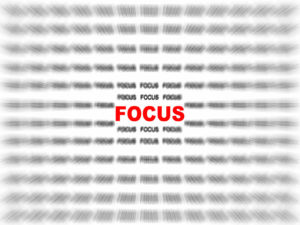
How to Treat and Prevent Vision-Damaging Near-Point Stress
Our eyes have evolved quite a bit since the dawn of human existence. We can see in incredible detail, color and precision. And we are among some of the animals with the best vision.
However, there is one aspect of our vision that remains linked to our ancient ancestors. Our eyes are those of a predator. We are on top of the food chain, after all, so it’s only logical that we should have the eyes of a predator. Our ancestors were hunters and gatherers; they needed their distance vision to survive.
We sure have come a long way since then. As humans, we definitely continue to rely on our distance vision for things like driving. However, over the years, we have evolved to do more “close work.” Close work means that most of the work we complete is done up close to the eye, such as reading or sewing. People who work in an office are particularly susceptible to this.
Close work is a part of our everyday life. This is especially true for office workers and students. We have shifted as a species in our daily habits, but our eyes are stuck in the past and our new habits could be damaging our eyes.
What Is Near-Point Stress?
As a result of our slowly evolving eyes, everyone is at risk of experiencing near-point stress. Simply put, close work is harming our vision!
Students may not be aware of the term ‘near-point stress,’ but there is no doubt that they have experienced it at some point. Students are most at risk because of the extended time they spend reading and writing.
When you’re in class taking notes and have to look up at the board, does your vision get blurry? Yes? Well, then you’ve just experienced near-point stress.
Going from using your near vision and quickly shifting to distance vision is what causes near-point stress.
Even if you aren’t a student, you have most likely experienced this. We’ve all stared at our phones for too long, only to look away and have blurred vision. Our eyes normally adjust after a second or two and then we go right back to using our digital device.
Myopia Caused by Near-Point Stress
A common misconception is that near-point stress won’t harm your eyes. Your eyes are meant to be able to focus back and forth between near and distance vision. While this may be true, too much close work can cause myopia, otherwise known as nearsightedness.
Myopia is a refractive error where your close vision is good, but your distance vision is blurred.
How does near-point stress cause myopia? It’s pretty simple, actually. To focus on close work, the lens of the eye has to bend. As a result, the muscles in the eyes strain themselves. When this strain goes on for a long period of time, the muscles can start to spasm. This spasm will result in myopia.
Of course, near-point stress won’t cause myopia right away. No one knows exactly how much time it takes for the condition to develop. Everyone is different. However, one thing is for sure. Extended periods of close work without breaks will definitely ruin your distance vision.
Other Symptoms
Near-point stress is very similar in terms of symptoms to digital eye strain. Digital eye strain is caused by the excessive use of digital devices. The mechanics of the two conditions are the same. The eyes focus too long on something close, then when you finally look away, your vision is blurred.
Some other symptoms include headaches, excessive eyelid twitching, a burning sensation in the eyes, and overly watery eyes.
Not only will these symptoms affect your overall vision health, but you may also find yourself less productive. You’ll have trouble concentrating on your work. You have much more to gain from putting your eye health first before your close work.
How to Treat Near-Point Stress
Treating near-point stress is very easy. It doesn’t often require medical attention unless the condition evolves into myopia. If your distance vision is permanently affected by your close work, talk to your doctor. They will offer options to help your eyes relax and get back to normal.
For the rest of us, treatment is simple. First off, all you need to do is take a break. We know that breaks are a luxury when you’re racing against the clock to get your essay done before midnight.
However, taking breaks has proven to make people more productive. By not giving yourself a tiny break, you’re lessening your chances of getting that essay done on time.
A good rule to live by is the 10-10-10 rule. Every 10 minutes look at something 10 feet away for 10 seconds. That’s right! A 10-second break is all you need. This barely cuts into your work or study time.
Keep Your Distance from Your Work!
Another way to prevent near-point stress is to position your close work at an appropriate distance from the eyes. As everyone is different, a good rule is that whatever you’re working on should be at arm’s length.
Books, notebooks, computers, phones, and knitting are all things that should be at least an arm’s length away. Any closer to the eye and the muscles in your eyes will have to strain to see.
The last recommendation we have requires a bit of a time commitment, but it’s worth it. The best way to avoid near-point stress is to increase the flexibility of the lens in your eye. Believe it or not, it is possible!
The results will take a while to present themselves, but they will be worth the wait. Your eyes will be stronger and healthier and better equipped to do close work. The best way to increase the flexibility of your lens is to consume the right vitamins.
The best nutrients and vitamins for your lenses are vitamin A, vitamin C and omega-3 fatty acids. You can find these three nutrients in a variety of food such as fish and citrus fruits. And, highly pigmented vegetables like carrots and bell peppers. Supplements such as the Ocu-Plus Formula can also be a convenient alternative.
The next time you’re cramming for finals or are trying to meet a deadline, remember to put your health first. Take care of your eyes and your eyes will take care of you!
Our Rebuild Your Vision Ocu-Plus Formula Contains All 17 Vitamins, Minerals, and Herbal Supplements to Improve Your Eye Health!













A good article once gain, the modern era creates problems for humankind, but you are helping to foresee such issues and offer a remedy.
Very good info, I have maculardegeneration in both eyes however I get a shot in my right eye about every 45 days and the vision stays at about 20/40, The left eye is vision dry Mac, every morning I eat 6 or seven raw leaves of spinach, a quarter of a raw red bell pepper, 8 or nine raw blue berries, I grate a raw carrot into a glass V8 juice, and take two AREDS 2 pills per day and I excerse two hours each morning. Would like your opinion, coments and suggestions.
Ira Waterman
Eighty six years of age